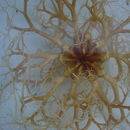en
names in breadcrumbs


"On the west coast of North America from Alaska to California, the Bering Sea to the Sea of Japan, Okhotsk Sea, Laptev Sea, across the Arctic to Greenland, Finmark, Spitzbergen, and south to Cape Code; 8-1850 metres." (Lambert, Austin 2007)
"Disc: Up to 14 cm in diameter, indented between the radial shields and covered with thick skin. The radial shields taper towards the centre where they nearly meet with opposite shields; they are densely covered with scales bearing rough granules.
Arms: Branching and coiling at the tips, the arms are higher than their width in cross-section and have up to five lateral arm spines, four or fewer on distal branches. The spines have hooks with three teeth. Hooks are also borne on the vertical ridges of embedded plates on the dorsal and lateral arm surfaces.
Mouth: Contains spine-like teeth and oral papillae.
Colour: Usually tan with dark brown markings on the dorsal side of the disc, but throughout its range this species can be maroon, reddish, orange, salmon, pink and white." (Lambert, Austin 2007)
"The sex ratio of animals around the San Juan Islands is about 1:1, with 2.6 per cent hermaphrodites. The gonads grow during the summer, and spawning occurs from October to February. New gametes begin to form immediately after spawning, but development pauses until later in the cycle when final maturation takes place. This pause corresponds to a seasonal reduction in plankton density. Early larvae have no locomotory structures and they appear to be passively captured by Gersemia polyps, in which they being their life history. Animals grow rapidly up to a disc size of 5.5 cm." (Lambert, Austin 2007)
"Juveniles of this species inhabit the pharynx of the feeding polyps of the sea strawberry Gersemia up to a size of 0.5 cm disc diameter. At this stage they possibly intercept the food collected by the polyp. Later they can be found attached to adult basket stars while feeding on plankton. Up to five young were found clinging to an adult. As adults they attach to the substrate with some of their arms and extend the others into the water in a dish-like shape facing the current. Plankton caught by hooks on the arms are rolled up in strings of mucus, and then transferred to the mouth. In the stomach, prey are wrapped in bundles of mucus. Gorgonocephalus eucnemis eats mostly crustaceans and arrow worms with an occasional fish embryo or jellyfish. Without cilia on the arms, this species will not likely capture unicellular organisms." (Lambert, Austin 2007)